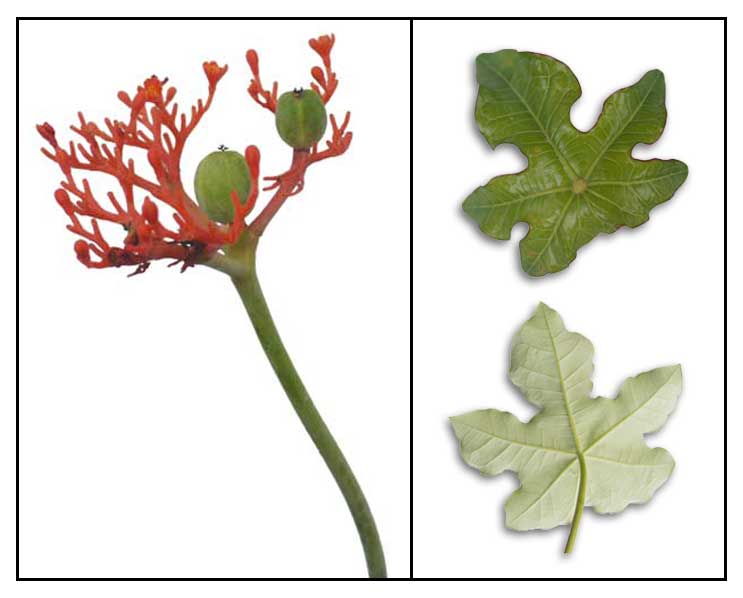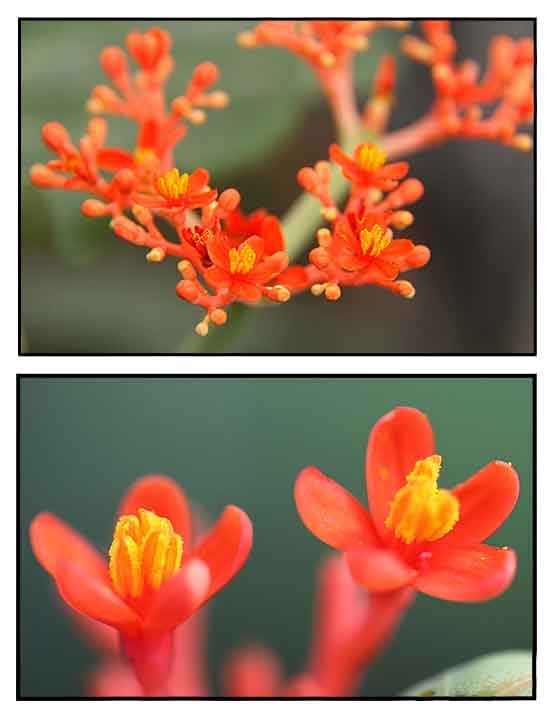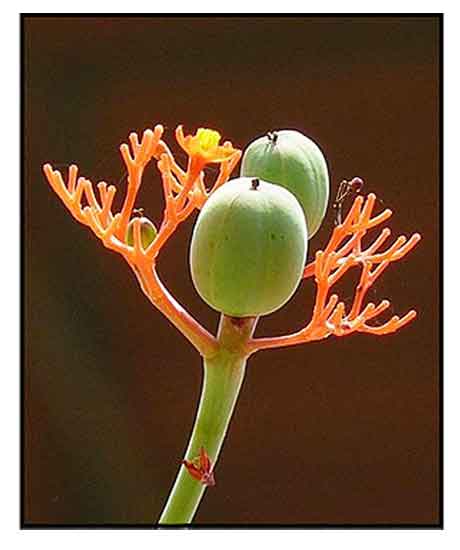 Gen info Gen info
-
Jatropha podagrica is a succulent plant in the Euphorbiaceae family, native to the tropical Americas but grown as an ornamental in many parts of the world.
-
Etymology: Jatropha podagrica derives from the Greek 'iatros' meaning healer and trophe, food. Species epithet podagrica derives from podagra meaning 'foot gout,' especially of the big toe, or podagrikos, liable to gout.
- Buddha belly name alludes to its thick and swollen trunk.
 Botany Botany
Buddha belly is a tropical, succulent or sub-woody shrub, growing to a height of 0.5 to 1 meter. Stem is swollen, knobby, gray-skinned, with a large bottle-like caudex. Petioles are 8 to 10 centimeters. Leaves are peltate, glossy green adaxially, gray-green abaxially, margins entire, wavy, or shallowly 3- to 5-lobed, 6 to 8 palmate veins, up to 12 inches in diameter, with a stout stalk attached on the underside of the leaf. Flowers are small, bright red or orange-red, and coral-like clusters at the tip of a long red stalk. Fruits are capsules, ellipsoidal, about 1.5 centimeters , with 3 longitudinal grooves, initially green and fleshy, maturing to dark brown and explosively dehiscent to yield 2 to 3 black seeds, scattering them 3 to 4 meters away. Seeds are smooth and glossy brown, about 1.5 to 2 centimeters long.
J. podagrica is similar to J. curcas and has a thick gouty stem, a thin, often greenish bark which exudes copious amounts of watery sap when cut. (1)
Distribution
- Introduced.
- Cultivated for ornamental purposes.
- Native to El Salvador, Guatemala, Honduras, Mexico, Nicaragua.
Constituents
- Contains a purgative oil and a phytotoxin or toxalbumin (curcin) similar to ricin in Ricinis.
- Seed yields a purgative oil (40%), known as hell oil, pinheon oil, oleum infernale or oleum ricini majoris, which contains a small amounts of the irritant curcanoleic acid—related to ricinoleic acid and crotonoleic acid, the principle active ingredients of castor oil and croton oil. (Joubert et al., 1984) (1)
- The genera may also contain (1) hydrocyanic acid (Critical Reviews in Toxicology, 1977) (2) a dermatitis producing resin (Lampe & Fagerstrom, 1968) (3) an alkaloid and a glycoside which produce cardiovascular and respiratory depression.
(1)
- Latex yields an alkaloid, jatrophine.
- Crude methanol extract of stem bark
yielded six compounds: fraxidin (1), fraxetin (2), scoparone (3), 3-acetylaleuritolic acid (4), β- sitosterol (5) and sitosterone (6).
(3)
- Phytochemical screening of stem bark yielded steroid and triterpenes.
(see study below)
(4)
- Study of roots yielded a new alipathic acid named japodic acid and two other known compounds, erythrinasinate and fraxidin, isolated from the plant for the first time. (see study below) (6)
- Study of root bark isolated one new lathyrane diterpenoid, Jatropodagrene, along with three known compounds. (see study below)
(9)
- In a phytochemical study, screening for secondary metabolites yielded alkaloids, tannins, flavonoids, saponins, and phenols in the leaves, roots, seed and stems. Percentage of tannins was 6.79% (leaves), saponin 3.15% in leaf and 2.44% in seed. Alkaloids in leaf was 0.33%, stem 0.15%, seed 0.18%, and root 0.26%.
- Ethyl acetate and methanol crude extracts yielded alkaloids, coumarins (M), flavonoids, steroids (EA), tannins, phenols (M). Total flavonoid content of ethyl extract of leaves was 7.80 ± 0.89 µg QE/g.
(see study below) (12)
- Study of leaves for phytoconstituents yielded flavonoids, phenolic acids, glycoflavones, steroids, and proanthocyanidins. (13)
- Studies for bioactive compounds have isolated Japanese acid, erytrinasinate, fraxidine, steroids and flavonoids, podacyclin A and B, diterpenoids japod
dagrone, japodagrine, 3-acetylaleuritolic acid, japodagrol, n-heptyl ferulate and sitosterol, tetramethylpyraze. Secondary metabolites, including fraxidine, fraxetine, scoparone, 3-acetylaluritolic acid, sitosterol, and sitosterone have been isolated from the stem bark. (17)
- Study of stems isolated two new lathyrane-type diterpenoids, jatropodagins A and B (1 and 2), and five known analogues (3-7).
(see study below) (18)
- Two novel cyclic peptides were isolated from the latex: podacycline A and B. (24)
Properties
- Toxicity: All plant parts are poisonous, especially the seeds.
- Roots considered antibacterial, antifungal, aphrodisiac.
- Studies have shown antimicrobial, insecticidal, antiviral, antitumor, antiproliferative, antioxidant, wound healing, anti
trypanosomal, hypotensive properties.
 Toxicity / Poison Concerns Toxicity / Poison Concerns
-
All plant parts are considered toxic, but in particular the seeds. In children, as few as 1 to 3 seeds can cause symptoms.
- Main toxins are the purgative oil, phytotoxin, or toxalbumin (curcin), similar to ricin in Ricinis.
- The plants are particularly attractive to children. Seeds are white and oily in texture, and reported to have an agreeable taste. (1)
- Symptoms occur about half an hour after ingestion of seeds, with acute abdominal pain and burning sensation in the throat, followed by nausea, vomiting, and diarrhea, sometimes with blood in the vomitus and feces. There may be CNS depression.
- Main risks are dehydration and cardiovascular collapse as a result of hemorrhagic gastroenteritis.
- Children are more susceptible.
- Treatment: (1) Give fluids by mouth to dilute the poison and seek medical advice. (2) Induction of vomiting and gastric lavage are treatment options in the hospital or health care facility. Activated charcoal and catharsis may hasten elimination. (3) Sap can cause contact dermatitis. Wash affected skin areas with mild soap and plenty of water. (5) If sap gets in contact with the eyes, flush eyes with plenty of water for at least 15 minutes. (1)
- In some instances as few as three seeds produce toxic symptoms. In others, consumption of as many as 50 seeds results in only mild symptoms. It has been suggested there may be variants without seed toxicity.
- Symptoms of poisoning are likely to be similar for species of Jatropha. (see: Tubang-bakod/ Jatropha curcas)
- Dermatitis: When cut, the plant exudes copious sticky sap that can cause contact dermatitis.
Parts used
Roots, seeds, fruit, flower.
Uses
Folkloric
- In the Quezon province, where some refer to it as "ginseng," roots are pounded and steeped in lambanog for its imagined male tonic, aphrodisiac, and erectile-assistive (viagra) effect.
- The Subanens in Dumingag, Zamboanga del Sur, who call it ginseng, apply crushed roots to wounds. (10)
-
In China, plant used for pain relief, reduction of swelling, and detoxifying snake bites.
- Roots used for treating infections.
- Used to treat jaundice, gonorrhea.
- In traditional folk medicine in many parts of Africa. Seeds have been used as purgative, anthelmintic, and abortifacient; also for the treatment of gout, paralysis, and skin diseases. Seed oil used as ingredient in treatment of rheumatic conditions, pruritus, and parasitic skin diseases. Leaves have been used as hemostatic agent. (1)
- In Africa, some chew seeds when in need of a laxative. (1)
-
In the DR of Congo, stem and roots used as chewing sticks. Plants used as antipyretic, diuretic, choleretic and purgative.
- In Ghana and Nigeria, used as antipyretic, diuretic, choleretic and purgative. (3) In Nigeria, used for parasitic skin infections and hepatitis. (9)
-
Despite the poisonous nature of the plant and its more toxic relative J. curcas, small quantities are used in natural remedies and homeopathic medicine. It is externally applied to skin disease and rheumatism. Leaf juice applied to hemorrhoids. (2)
- In Brazil, used to expel intestinal worms.
- In Myanmar, used for toothache, menstrual disorders, glossitis, postpartum disorders. Decoction of fruit, leaf, and flower used as mouthwash for dental and oral diseases. Resin used for healing various ulcers. (5)
Others
- Fish poison: Bark used as fish poison. (1)
- Seed oil: Oil extracted from seeds used as ingredient in soap making. Also, use as lamp illuminant. (2)
- Biofuel: Seed oil potential source of biofuel.
- Fumigant: Leaves burned to fumigate houses against bed-bugs. (2)
- Ritual: Plant used by voodoo practitioners to drive away evil spirits.
- Tanning: In Mexico, use for tanning leather and producing red dye.
Studies
• Secondary Metabolites / Stem Bark: Study of crude methanolic extract of stem bark yielded six compounds. (see constituents above) (3)
• Antimicrobial: Study investigated the antimicrobial potential of hexane extracts of stem and stem bark against ten clinical isolates. Stem bark extract showed remarkable antibacterial activity compared to the stem extract, with greater zones of inhibition against E. coli and S. aureus compared to that of ampicillin and streptomycin. Stem bark also showed inhibition of Candida albicans, moderate compared to fluconazole. (see constituents above) (4)
• Japodic Acid, Fraxidin and Erythrinasinate / Antibacterial / Insecticidal / Roots: Study of roots yielded a new alipathic acid named japodic acid and two other known compounds, erythrinasinate and fraxidin. Japodic acid showed mild insect growth inhibition against Helicoverpa zea (37% at 100 ppm). Fraxidin and erythrinasinate showed antibacterial activity against Bacillus subtilis. (6)
• Cytoprotetive / Anti-Tumor / Antioxidant: Study evaluated a hydroalcoholic extract of J. podagrica for antiproliferative, antioxidant and cytoprotective effects. Results showed JP has antioxidant effect even in the presence of free metal ions, although with less efficiency. The extract also showed antitumor activity against A549 and PC12 cells. (7)
• Antiproliferative / Anti-Tumor / Antioxidant: Study evaluated the antioxidant, protective properties, and antiproliferative capacity of Lycium europeaum and Jatropha podagrica extracts on proliferation and evolution of A547 (ovarian cancer cell line), OVCAR-3 (human ovary adenocarcinoma cell line), A548 (human lung adenocarcinoma cell line) and PC12 (rat adrenal medulla pheochromocytoma cells). Results showed LE and JP may inhibit proliferation of cancer cells and induce apoptosis and could provide protection from oxidative stress diseases through its high antioxidant molecules content. (8)
• Anti-Hepatitis C Virus Activity / Diterpenoids / Stem Bark: Study of stem bark yielded a new lathyrane diterpenoid, Jatropodagrene (1), along with three known compounds. Compound 1 was highly cytotoxic (98.86% inhibition) to the HC virus, while compounds 2 and 3 displayed significant anti HCV activity. (9)
• Insecticidal / Antimicrobial: Study of crude solvent extracts of J. podagrica against Bactrocera cucurbitae showed lethal dose (LD50 and LD90) against of 0.29 and 1.46, and 2.44 and 12.30 for EA, respectively; and 0.39 and 1.54 ME and 0.41 and 1.62 EA against Bactrocera zonata, respectively. Various crude leaf extracts showed high antimicrobial activity against Staphylococcus epidermis and Bacillus algicola and moderate activity against E. coli, Listeria innocua, P. mirabilis, S. typhimurium, S. aureus, among others. (see constituents above) (12)
• Wound Healing / Leaf Ointment: Study evaluated the wound healing rate of Buddha belly leaf ointment on incision wound model in albino rats. Results showed significantly (p<0.05) higher rate f wound healing and reduced epithelization period in a dose-dependent manner. Best results were obtained with ointment formulation with highest concentration of 2ml/10g ointment. (14)
• Antitrypanosomal / Cytotoxic: Study evaluated 71 medicinal plant specimens from 60 plants species in Myanmar for antitrypanosomal activity against trypomastigotes of Trypanosoma evansi and cytotoxicity against MEC-5 cells in vitro. Jatropha podagrica fruits exhibited remarkable antitrypanosomal activity with IC50 of 52.3 ± 13. µg/ml against T. evansi with selectivity index of 12.5. Cytotoxicity against MRC-5 was 652.7 ± 202.9. (15)
• Tetramethylpyrazine / Hypotensive and Neuromuscular Actions / Stem: Study evaluated the neuromuscular and cardiovascular activities of an amide alkaloid, tetramethylpyrazine (TMPZ) isolated from the stem of J podagrica. Results showed neuromuscular-blocking and hypotensive effects. The neuromuscular activity was similar to that of d-tubocurarine. The hypotension was not altered by cervical bilateral vagotomy, atropinization or mepyramine pretreatment, suggested unlikely mediation by cholinergic or histamine Ht-receptor stimulation mechanisms. (16)
• Lathyrane Diterpenoids / Antitumor Activity in Human Osteosarcoma Cells / Stems: Study of stems isolated two new lathyrane-type diterpenoids, jatropodagins A and B (1 and 2), and five known analogues (3-7). The compounds were evaluated against two human osteosarcoma cell lines (Saos-2 and MG-63). Compound 1 exhibited significant cytotoxic effects with IC50s of 8.08 and 14.64 µM, respectively, compared to positive control 5-FU with 19.01 and 25.00 µM, respectively. Morphological studies confirmed dose-dependent apoptosis. (18)
• Xanthine Oxidase Inhibition / Antigout Potential / Stem Bark: Study evaluated the activity of antioxidants against xanthine oxidase in bioactive extracts from J. podagrica stem bark. Among tested extract, the ethyl acetate extract showed strongest antioxidant activity and xanthine oxidase inhibition. Column chromatography identified five fractions, M1-M5. M3 (methyl gallate, fraxetine, and tomentin) showed highest level of xanthine oxidase inhibitors (IC50 69.7 µg/mL) followed by M5 (fraxetin) with IC50 of 106.9 µg/mL. Results suggest alternative and potential source of treatment for gout. (19)
• Biodiesel Potential of Seed Oil: Study evaluated the potential of J. podagrica seed oil as feedstock for biodiesel production. Seed oil extracted with n-hexane from milled kernels were characterized for free fatty acids, iodine value, viscosity, saponification value, density and acid value. J. podagrica seeds showed high oil content compared to J. curcas. Main fatty acid components were oleic acid (15%) and linoleic acid (70%). Study suggests potential for biodiesel production and a two-step acid-catalyzed transesterification process would be appropriate. Physicochemical analysis suggests the seed oil could be very useful for production of soap and shampoo. (20)
• Green Corrosion Inhibitor for Carbon Steel / Stem Bark: Study evaluated the inhibition efficacy of a novel green corrosion inhibitor based on J. pedagogical stem bark extract explored by integrated experimental and computational studies. Polarization tests showed mixed type inhibitor with dominant effect on cathodic reactions restriction. Theoretical results demonstrated adsorption of stem bark extract constituents on the carbon steel substrate in parallel mode. (21)
• Intricateness / Anti-Inflammatory / Stems: Study of stems of J. pedagogical isolated intricateness A (1), new interpenetrated, (1) along with eight known interpenetrates (2-9). All compounds were evaluated for anti-inflammatory activity. Compound 3 showed significant inhibitory effects against nitric oxide (NO) production in lipopolysaccharaide (LPS)-induced RAW264.7 macrophage cells with IC50 of 13.44 µmol/L, comparable to positive control quercetin (IC50 17.00). (22)
• Effect on Blood Clotting and Wound Healing: Study evaluated the efficacy of Jatropha podagrica, Chromolaena odorata and Centella asiatica on the reduction of blood clotting and promotion of wound healing in notched piglets. Wound healing score using fresh exudes of J. podagrica was significantly higher than control. (p<0.05). Application of fresh exudes showed bleeding time of 11.73 seconds while control group was 35.45 seconds. Results showed reduced blood clotting time and promotion of wound healing. (23)
• Venom Neutralizing Herbal Preparation: Study evaluated evaluated the neutralizing ability of a herbal preparation practiced in indigenous medicine of Sri Lanka to neutralize venom toxins of Naja naja (common cobra) and Dabaia russelii (Russell's viper). The herbal preparation was prepared by mixing together aqueous extracts of crushed leaves of Jatropha podagrica, Sansevieria cylindrica, with a drop of extract of Citrus aurantiifolia fruit. The herbal preparation exhibited a clear neutralizing action against toxicities of D. russelii and N. naja venoms. Results suggest potential as antidote for snake envenomation. (25)
Availability
- Cultivated.
- Seeds in the cybermarket. |

![]()



 Gen info
Gen info Botany
Botany
